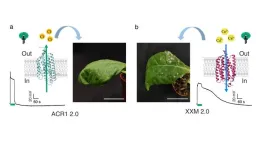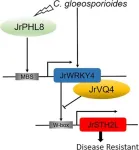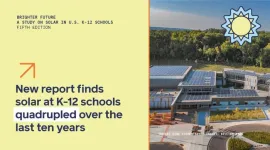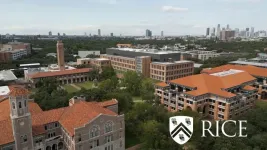(Press-News.org)
Researchers at the University of Massachusetts Amherst and UMass Chan Medical School have demonstrated in mice a new method to combat pancreatic cancer. The study, published in Science Translational Medicine, outlines the synergistic effects of a novel nanoparticle drug-delivery system to activate an immune pathway in combination with tumor-targeting agents.
Pancreatic ductal adenocarcinoma (PDAC) is the most common form of pancreatic cancer. With a dismal,13% five-year survival rate, it is the third leading cause of cancer deaths.
One major challenge is the microenvironment surrounding the tumor. This environment is characterized by dense tissue creating a barrier around the tumor that inhibits blood vessel formation and blocks immune infiltration.
“Drug delivery is a huge challenge due to the architecture of these difficult-to-treat tumors’ microenvironment,” says Prabhani Atukorale, assistant professor of biomedical engineering at UMass Amherst and one of the corresponding authors of the paper. She adds that the environment also blocks the activation of the body’s immune cells and their penetration into the tumor.
“Pancreas cancer, unfortunately, doesn’t respond to most conventional therapies like chemotherapy, or even immunotherapy, which has revolutionized a lot of cancer therapy in the last 10 years,” says Marcus Ruscetti, assistant professor of molecular, cell and cancer biology at UMass Chan Medical School, and the other corresponding author.
Ruscetti’s previous research demonstrated that two cancer drugs (MEK inhibitor trametinib and CDK4/6 inhibitor palbociclib, or T/P) can promote blood vessel development, enabling greater T cell (as well as chemotherapy) delivery into the tumor. However, the cancer “tricks” the immune system into thinking that the tumor is just a regular, healthy clump of cells. Since the T cells aren’t activated, simply having more of them present won’t clear the cancer.
Here’s where the researchers want to implement a trick of their own. The first pathway is called the stimulator of interferon genes (STING) pathway. STING recognizes viral infections in the body. “If we can trick the immune system into thinking that there is a viral-type
infection, then we harness a very robust anti-tumor immune response to bring in for tumor immunotherapy,” Atukorale explains.
The researchers also wanted to activate the TRL4 pathway because it boosts the effects of STING activation. They use agonists, which are any chemicals that can trigger a biological response; in this case, in immune stimulatory pathways. But getting these immunity-triggering chemicals through the tumor’s microenvironment is still a challenge.
The researchers’ solution: encapsulating the STING and TRL4 agonists in a novel design of lipid-based nanoparticles. The nanoparticles have several benefits. First, the research demonstrated that they are highly effective at delivering the agonists into the challenging tumor microenvironment.
The design also allows both of the agonists to be packaged together — a challenge since these two mix as well as oil and water. “It ensures that they are carried within the blood circulation together, they reach the same target cell together and are taken up together by the same target cell,” says Atukorale.
“We’re using biocompatible, lipid-based materials to encapsulate drugs that functionally work together, but don’t like to be next to each other, and then we are able to use engineering capabilities to build in various functionalities to direct them where they need to go,” she says.
The synergistic effect of the two agonists plus the T/P therapy proved effective: eight out of nine of the mice saw tumor necrosis and shrinkage. “And we had two mice that had complete responses, meaning the tumors completely went away, which is pretty striking,” says Ruscetti. “We’ve never seen that in this model before.”
There is still work to be done because the tumors returned after the mice were taken off of the treatment, but Ruscetti says it is still a very encouraging step toward a cure.
“If you go beyond pancreas cancer to other cancer types, you need a combination therapy to target the tumor and to target the immune system,” he adds. “This is a strategy to be able to do that.” Treatments for cancers like PDAC that could be derived from this study include mutations of colon cancer, lung cancer, liver cancer and cholangiocarcinoma (cancer of the bile ducts).
Prabhani adds that the modular nature of this design allows for therapies that can be easily personalized for patients. “It’s sort of plug and play,” she says. “We can tailor the agonist ratios, the drug combinations, the targeting molecules, but keeping essentially the same platform. This is what will make it hopefully translational, but also tunable on a per patient basis, because many of these cancer therapies need to be personalized.”
Finally, she nods to the power of collaboration between the two UMass institutions, saying, “This type of system is easily built when you have complementary, but multidisciplinary and cross-disciplinary, expertise.”
END
An archaeogenetic study sheds new light on the isolated medieval community Las Gobas in northern Spain. Besides isolation and endogamy, the researchers have also identified the variola virus which can offer a new explanation on how smallpox entered Iberia.
Researchers from Sweden and Spain have conducted a comprehensive archaeogenetic study on a community that lived on the border between the northern Christian kingdoms and Al-Andalus during the early Medieval period. This dynamic era, especially ...
A new discovery by researchers at the RIKEN Center for Biosystems Dynamics (BDR) in Japan upends decades of assumptions regarding DNA replication. Led by Ichiro Hiratani and colleagues, the experiments published August 28 in Nature show that DNA replication in early embryos is different from what past research has taught, and includes a period of instability that is prone to chromosomal copying errors. As failed pregnancies and developmental disorders are often related to chromosomal abnormalities the findings could impact the field of reproductive medicine, perhaps leading to improved methods of in vitro fertilization (IVF).
During embryogenesis, ...
NEW YORK, NY (Aug. 28, 2024)--An analysis of more than 1.6 million brain cells from older adults has captured the cellular changes that occur in the early stages of Alzheimer’s disease, potentially revealing new routes for preventing the most common cause of dementia in older individuals.
The study also identified a second community of cells that drives the older brain down a different path that does not lead to Alzheimer’s disease.
“Our study highlights that Alzheimer’s is a disease of many cells and their interactions, not just a single type of dysfunctional ...
When it comes to survival, plants have a huge disadvantage compared to many other living organisms: they cannot simply change their location if predators or pathogens attack them or the environmental conditions change to their disadvantage.
For this reason, plants have developed different strategies with which they react to such attacks. Such reactions are usually triggered by certain signals from the environment. As has long been known, the intracellular calcium concentration plays an important role in the processing of these signals.
However, in addition to changes in the cytoplasmic calcium level, changes in the cell's ...
A pivotal study has pinpointed a gene module crucial for enhancing walnut trees' resistance to anthracnose, a widespread fungal disease threatening the walnut industry. The research reveals how the JrPHL8-JrWRKY4-JrSTH2L module regulates disease defense, opening up new opportunities for breeding resistant walnut varieties and promoting sustainable cultivation practices.
Anthracnose, caused by Colletotrichum gloeosporioides, poses a significant threat to walnut production, causing severe losses ...
Roadway-related incidents are a leading cause of flood fatalities nationwide, but limited flood-reporting tools make it difficult to evaluate road conditions in real time.
Existing tools — traffic cameras, water-level sensors and even social media data — can provide observations of flooding, but they are often not primarily designed for sensing flood conditions on roads and do not work in conjunction. A network of sensors could improve situational flood level awareness; however, they are expensive to operate at scale.
Engineers at Rice University have developed a possible solution to this problem: an automated data ...
NEW ORLEANS – Ochsner Health has announced David A. Schwartz, MD, as the 2024 winner of the Alton Ochsner Award Relating Smoking and Disease. Dr. Schwartz is a Distinguished Professor of Medicine and Immunology and director of the Program to Advance Physician Scientists and Translational Research at University of Colorado’s Anschutz School of Medicine.
Dr. Schwartz won the 39th annual Alton Ochsner Award for his research on how genetic and environmental factors, including smoking, contribute to idiopathic pulmonary fibrosis (IPF). He found that ...
Charlottesville, VA — Schools across the country are rapidly switching to solar power to meet their energy needs while gaining significant cost-savings, boosting climate resilience, and supporting workforce development, according to a new report from clean energy nonprofit Generation180. Since the start of 2014, the amount of solar capacity installed at K-12 schools has more than quadrupled nationwide.
According to Brighter Future: A Study of Solar on K-12 Schools, 5th edition, over 6.2 million U.S. K-12 students– or more than one in nine students – now attend a school that utilizes solar power. In 2022-2023, over 800 schools added solar arrays, which is enough ...
HOUSTON – (Aug. 28, 2024) – Rice University researchers have developed a smart material that adjusts its transparency with changes in temperature, outperforming similar materials in terms of durability, transparency and responsiveness. The new polymer blend could significantly enhance energy efficiency for indoor space cooling, according to a new study published in Joule.
Cooling off can be a matter of life or death, but air conditioning ⎯ when and if available ⎯ already accounts for 7% of the world’s energy use and 3% of carbon emissions. With temperatures hitting record ...
The Damon Runyon Cancer Research Foundation has named 16 new Damon Runyon Fellows, exceptional postdoctoral scientists conducting basic and translational cancer research in the laboratories of leading senior investigators. This prestigious Fellowship encourages the nation's most promising young scientists to pursue careers in cancer research by providing them with independent funding ($300,000 total) to investigate cancer causes, mechanisms, therapies, and prevention.
“What is so exciting—and so challenging—about being a postdoc is that you’re called to take what you know and apply ...







